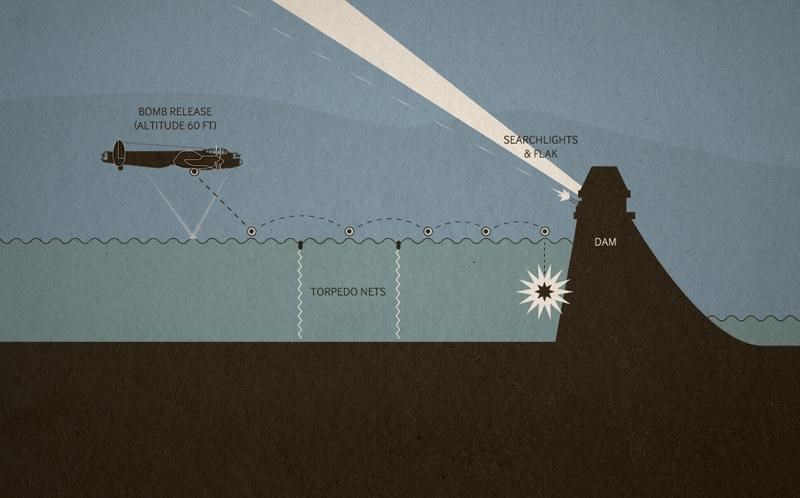The skies were quiet over Germany on May 16-17, 1943, as 19 Lancaster bombers crewed by Canadians, Brits, Aussies and Kiwis participated in a daring nighttime raid codenamed Operation Chastise — or as it was later famously known, The Dambusters Raid.
The goal was to blow up three river dams in Germany’s industrial heartland in the Ruhr Valley. It was hoped this would disrupt water supplies for industrial production and divert resources from other aspects of the German war effort.
Of the 133 airmen who flew that night, 30 were from the Royal Canadian Air Force, including three men from the Moose Jaw area: Flying Officer Robert Alexander (Turk) Urquhart, Pilot Officer Ken Brown and bomb aimer Sgt. Stefan Oancia from Stonehenge southwest of Assiniboia.
The operation was of great difficulty, demanding very low flying and a high degree of skill, courage and close co-operation among the crews.
A bouncing bomb
The mission was difficult because the dams were solid; the Möhne dam alone was 33 metres thick at the base. Furthermore, they were fiercely protected, with torpedo nets stopping underwater attacks and anti-aircraft guns defending against enemy planes.
The answer for 617 Squadron lay in an innovative but complicated weapon: the 5,000-pound bouncing bomb. Developed by British engineer Barnes Wallis, the drum-shaped bouncing bomb needed to be dropped from 18 metres (60 feet) and at a ground speed of 374 kilometres per hour (232 miles per hour) — while flying straight for seven seconds.
The bomb would spin backwards across the water’s surface before reaching the dam. Its residual spin would drive the explosive down the dam’s wall and explode at its base.
Led by famous 24-year-old Wing Commander Guy Gibson, the squadron left its base at 9:28 p.m. By 12:28 a.m., the planes had breached the Möhne and Eder dams but failed to destroy the Sorpe.
During the raid, 53 men were killed and three became prisoners of war. On the ground, almost 1,600 people were killed in the flooding. Although the effect on Germany’s industrial production was limited, the raid boosted morale in Britain.
Moose Jaw’s Ken Brown, 22, received the Conspicuous Gallantry Medal (CGM) after the battle, only the second-ever Canadian to receive that award. He survived the raid and died on Dec. 23, 2002.
Memories of the raid
“That night, we were perched out on the grass. It was a beautiful night, clear sky, no cloud, waiting for the buses to take us out to the aircraft. John Burpee, a Canadian — Pilot Officer Burpee — came over to me and thrust out his hand and said, ‘Goodbye, Ken,’” Brown recalled on July 13, 1993 during a 50th-anniversary commemoration event.
“I said, ‘Goodbye, John.’ I didn’t expect he’d come back. You see some people feel that way.”
Brown’s feeling proved accurate, as Burpee was shot down and killed over the Netherlands flying toward Germany.
The pilots had to be aware of high-tension wire strung between poles since it was the greatest danger. If the moonlight highlighted the wire, the pilots had to fly either under or above it, depending upon where it was.
“It was that quick. We lost two aircrafts to those wires. They merely slapped into them. Deadly stuff,” recalled Brown.
At one point, Brown avoided a nearby plane that had exploded into an orange fireball by diving and following a heavily treed road.
“Then much to my consternation, that damn road led right into a castle, and I’ll never forget that castle door. We had to dip and the left wing went between two turrets as we went through the castle,” he said.
Objective complete
Brown’s objective was the Sorpe Dam, but the fog made that difficult. However, they dissipated the fog by conducting several runs against the dam and then dropped their payload.
“… we were pleased with it, and as far as the explosion was concerned, the waterspout went up to about a thousand feet, and so did we. I think we ended up about eight hundred.”
Although Brown and his crew faced enemy planes, searchlights and anti-aircraft fire on the way home, they returned safely.
Meanwhile, Stefan Oancia survived the raid and the war and received the Distinguished Flying Medal (DFM). However, Robert Urquhart was shot down and killed during the mission.
Mission fail
Urquhart was in the second Lancaster to attack the Eder Dam. However, during the attack run, the plane dropped its bomb too late. It struck the upper part of the dam and exploded, damaging the aircraft.
The pilot nursed the Lancaster back toward England, flying at 50 feet. Unfortunately, they clipped electrical transmission lines, sustained more damage, strayed over defended oil plants at Emmerich am Rhein, and were shot down. The crash killed all on board.
The crew — including Urquhart — was buried in the Reichswald Forest War Cemetery, Germany, after the war.
Urquhart, 23, posthumously received the Distinguished Flying Cross.




